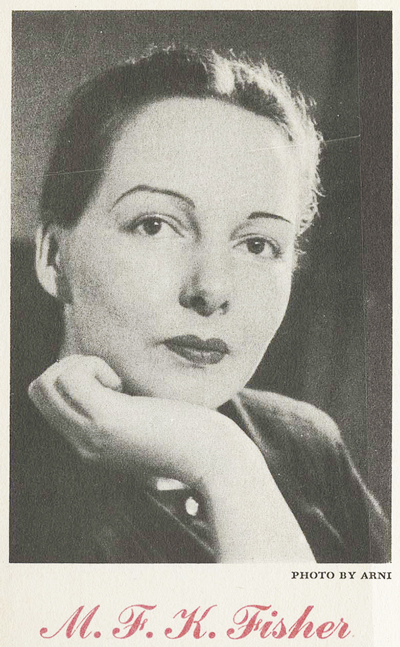Taste Blindness
Seeing the light with the right remedies
Over a career spanning a half century, M.F.K. Fisher’s 27 books on food, drink and conviviality earned her prime position among American authors.
Fisher (1908–1992) though born in Michigan, resided in California with the exception of her ex-pat adventures in France between world wars. She never lost her vitality or her fascination with America’s table rituals, though at times she was critical of its ersatz tendencies, preferring convenience and speed ahead of enjoyment and quality. Her continued lament describes “taste blindness.”

Taste blindness is no neurologic or genetic malfunction; it’s rather a choice to ignore the experience of taste pleasure at meals. It dispenses with all aspects of those stimulations in favor of mere utility pushing the joyous table away as if swatting at gnats.
What causes this myopia? I think the answer resides in our cultural DNA, with its impulse to get a move on. But there is something else. We carry a recessive gene of Puritanical prudery casting its long shadow over joyous occasions such as a leisurely meal, with flagons of wine throughout.
Because pleasure elicits guilt and woeful spasms of conscience, we fake denial but don’t shake the blindness, any more than the Romanovs or the House of Windsor could erase hemophilia. It follows us through the ages — how else to explain the time constraints of Happy Hour?
Fisher recounts farm-to-table food before American cooking and dining was consigned by modernity to the root cellar and the Mason jar — thus into the Orphic shade of nostalgia. Some of Fisher’s best writing recalls the rush to harvest, cook and store bounty for use over the somewhat imaginary long winter of a California homestead.
She also carries a theme through her food tomes, namely, human hunger — not in the weepy-Sally-Strothers-overnight-cable-TV-commercial sort of way. Its essence as fuel needed to preserve the race, so as to live and love well. The remedies for taste blindness advocate immediate connection among the farm, the kitchen and the table.
Writing a foreword to one edition of Fisher’s collections, James Beard suggests a direct regimen to combat taste blindness. It entails knowledge, practice and memory. Because wine is food in a different form, I apply Beard’s judgment to decoding grapes, since it’s become too easy in our enjoyment of wine to lose sight of what’s really happening.
In today’s 24-7, me-too, me-first information cycle, we lose sight of the point that tasting wine is not speed-dating. So, let’s slow down and examine the following considerations that can help you better navigate the sometimes-intimidating world of wine.
- Numbers worth knowing. Vintage refers to the harvest year, not the year the wine was released; i.e., put into the market. Vintage was established to help value wine. Vintage years vary, so general buzz about a “good year” refers to the quality of the fruit. Encountering a vintage helps identify wines of interest reflecting the overall characteristics of that specific growing season.
- More numbers to remember. Alcohol by volume and cost per bottle. The former helps set the latter, along with a component for preserving it.
- Numbers to avoid. These are wine ratings. They assign a point score like an applause meter. They are fake news geared to spike sales. Don’t fool yourself.
- Learn some geography. If you can find the mall with your GPS, you can also locate the area producing the fruit in your wine. It’s likely you’ll discover numerous possibilities in the same neighborhood, expanding your world of wine and ensuring additional enjoyment.
- Hyper-local wine. “Estate” wine originates from a winery’s surrounding vines, reflecting the qualities of a specific slice of planet Earth. If “block” is mentioned on a label, estate or otherwise, that slice has been further divided, possibly showing a distinction in taste — or a marketing approach.
- Wines weigh differently. Rosés are usually light-bodied, as well as Rieslings and Sauvignon Blanc. I class Pinot Noir as medium, but some are lighter, comparable to Beaujolais or Gamay. Wines of middle heft will include Merlot and more than a few Chardonnays. Cabernet Sauvignon and like-minded blends will be heavier-bodied. Sangiovese varies from light-middle weight but becomes heavier in blends that include Teraldigo or Merlot. Which do you prefer?
- The right kind of sweet. The mature palate handles acid, minerals and savory components better than a child’s. But it’s O.K. to prefer wine that stimulates our sweet receptors. Great ones exist, and some can cost oodles of money, but if you have a Barsac with fresh oysters, you’ll likely reach culinary ecstasy. Imagine the foods you could pair with this type of wine, and the blinders will fall away.
- Wines reveal more as they meet the greater environment. Your physical self is a big part of this environment. So when a wine really pleases, consider the context of the moment, your mood and other responses to what happens around you. There is much sensuousness in Fisher’s works, and it underlies her passionate approach to food and wine and company. It’s not an “experience,” but experience lived and remembered.
- No dumb questions. If you’re uncertain of a wine term, ask. The only dumb question is held in silence out of fear someone nearly as clueless on the same point, hands up a shovel of merde. Remember, you’re shopping for wine, not fertilizing the vineyard. You may not drink wines from the 1,400 varietals out there, but there’s no need to cram. Immediacy and extended pleasure helps everyone see better.
- Wine is like love. If you hold on too long, it will disappoint you like your prom date encountered at your 50th reunion. Maturity differs from timekeeping. Drink the good wine today.
Memory of wine, recalling Beard, may lead to ebullience, but as Madeline Puckette of Wine Folly recently wrote about tasting notes that read more like a poem than a description: “We’re talking about wine, not writing the sequel to ‘Leaves of Grass.’ Now, there’s no wrong answer when it comes to taste, and it’s important to remember feelings and sensations when drinking, but, it’s also equally important to put wine experiences into something that can be quantified: real tastes, real flavors. Wine is still a product, and each has a specific flavor that can be (more or less) defined.”
Good words celebrate goodness in wines. Save the numbers for Super Lotto.
Writer’s note: “The Art of Eating” is a collection of five short Fisher books in one tome. Beard’s tribute appears as a preface to one; all appeared around WWII but remain in print or audio versions.










